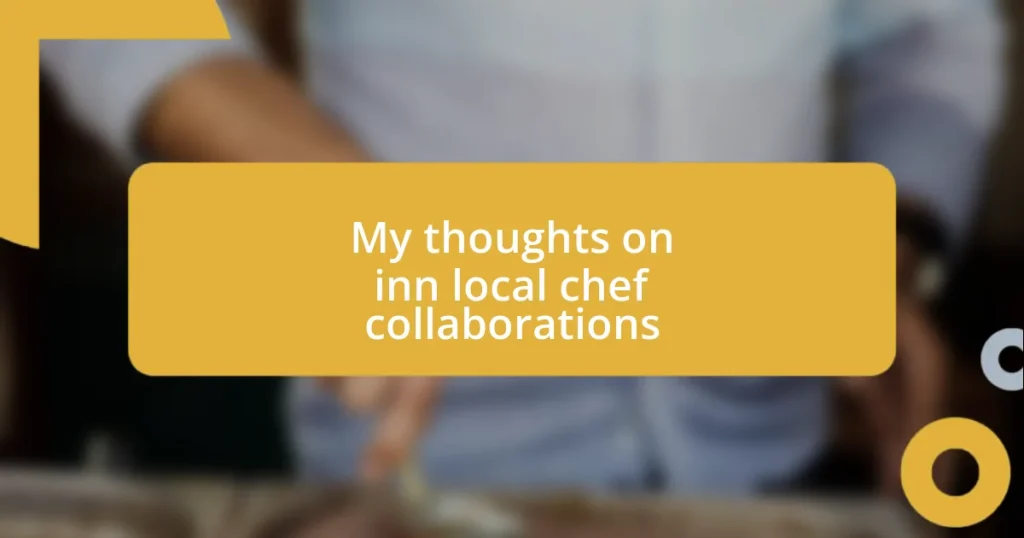Key takeaways:
- Inn chef collaborations enhance creativity and foster community by blending diverse culinary styles and philosophies.
- Building relationships and ensuring alignment in culinary philosophies are crucial for successful collaborations.
- Effective promotion of collaboration events through social media and local influencers can amplify reach and engage the community.

Understanding inn chef collaborations
Inn chef collaborations are fascinating, blending different culinary styles and philosophies. When I first witnessed a collaboration between a local farm-to-table chef and a pastry chef specializing in French desserts, I was amazed at how they transformed seasonal ingredients into a cohesive menu. The way they exchanged ideas and challenged each other creatively was truly inspiring.
Have you ever thought about what happens behind the scenes during these collaborations? I remember attending a pop-up dinner where a renowned local chef partnered with an up-and-coming chef. It felt like an artistic experiment, as their distinct flavors danced together on the plate, revealing new tastes I’d never experienced. The chefs’ passion for food and their shared excitement created an atmosphere that was electric.
The essence of inn chef collaborations lies not just in creating unique dishes but in fostering community. It’s heartwarming to see chefs supporting one another, sharing insights, and elevating each other’s crafts. This synergy cultivates a vibrant culinary ecosystem, where innovation thrives, and every experience feels like a story being told through food. Wouldn’t you love to taste the creativity that emerges from such partnerships?

Benefits of local partnerships
Local partnerships hold tremendous potential in the culinary world. I’ve always felt that when chefs unite, they bring together their unique flavors and techniques, creating something magical. The benefits extend beyond just the menu; you can literally see the spark in their eyes as they share ideas and explore new culinary frontiers together.
Here are some specific benefits of local partnerships:
- Enhanced creativity that results in innovative dishes.
- A stronger sense of community, promoting local farmers and artisans.
- Opportunities for skill sharing and professional growth for all involved.
- Increased customer engagement as diners are intrigued by collaborative events.
- Greater media attention, which can elevate a chef’s profile and draw in new patrons.
In my experience, events featuring local partnerships are often brimming with energy. I recall one memorable evening where two chefs, each with a distinct culinary background, created a fusion menu. Their enthusiasm not only resonated with each other but also connected deeply with the diners. The room buzzed with lively discussion, and it felt like we were all part of something special—a communal culinary experience.

Finding the right local chefs
Finding the right local chefs for collaboration is crucial. I often think about the importance of aligning culinary philosophies. It’s not just about skill; it’s about the shared vision that elevates the entire dining experience. Recently, I connected with a chef who specializes in fresh, local seafood. As we discussed our approaches, I realized how our collective passion for local ingredients could lead to inspiring new dishes that would excite diners.
When searching for local chefs, I recommend exploring their previous collaborations. I once attended a festival where chefs showcased their unique techniques. Watching them interact and communicate was eye-opening. Some chefs seamlessly complemented each other, while others seemed to struggle. Those moments taught me the value of chemistry in the kitchen—it’s vital for a successful partnership.
Networking within community events can also help identify suitable chefs for collaborations. I remember a local culinary event where I casually chatted with a chef whose work I admired. We discovered our mutual love for earthy flavors and spices. This small connection eventually led to a delightful pop-up dinner that exceeded our expectations. Building relationships takes time, but in my experience, those genuine connections yield the most rewarding collaborations.
| Factor | Consideration |
|---|---|
| Culinary Philosophy | Ensure alignment to create harmonious menus. |
| Previous Collaborations | Examine their past partnerships for compatibility. |
| Community Events | Participate to network and find potential collaborators. |

Creating a collaborative menu
Creating a collaborative menu is like painting on a shared canvas, where every chef contributes their unique strokes. I vividly recall a project where I teamed up with a baker known for his extraordinary pastries. Our discussions led to a dessert that was a playful twist—a savory pastry filled with seasonal fruit compote and topped with a hint of cheese. The joy on our faces as we tasted this fusion was unforgettable, exemplifying how collaboration can spark creativity beyond our individual styles.
When brainstorming ideas for a collaborative menu, I often find it helpful to keep an open mind. One evening, my culinary partner and I spent hours experimenting with different flavor profiles. It was during this playful exploration that we discovered a surprising synergy between smoky spices and fresh herbs. This delightful combination not only elevated our dishes but also underscored the importance of experimentation in a collaborative setting. Who knew a simple brainstorming session could yield such delicious results?
Ultimately, I believe the best collaborative menus tell a story—one that reflects both the chefs’ journeys and the local ingredients they cherish. I once participated in a dinner that featured dishes highlighting the farmers’ seasonal harvest. Each plate told the story of the ingredients’ journey, creating a connection among the chefs, diners, and the community. Isn’t it incredible how food can bridge gaps and bring people together, all while celebrating local flavors?

Promoting collaboration events
Promoting collaboration events is an exhilarating journey that requires creativity and a dash of strategic planning. I remember a vibrant food festival where several local chefs gathered to create unique dishes. Seeing the excitement in their eyes as they planned the menu together was contagious! It made me realize that the energy shared during such events not only promotes the chefs but also fosters a sense of community that diners truly appreciate.
To effectively promote these collaboration events, leveraging social media is invaluable. I once organized a pop-up dinner and utilized platforms like Instagram and Facebook to build buzz. Sharing sneak peeks of the chefs brainstorming and their culinary creations sparked curiosity. The day of the event, I was amazed to see food enthusiasts flooding in, eager to support this fusion of flavors. Isn’t it fascinating how a simple post can connect passionate food lovers with extraordinary local talent?
Another great strategy is engaging with local media and influencers. I vividly recall collaborating with a food blogger who attended our event, and her enthusiastic coverage sparked interest beyond our expectations. Her genuine excitement introduced our collaboration to a broader audience, amplifying our reach. It made me think: how can we all leverage our networks to elevate each other? By inviting influential voices into the mix, we not only enhance visibility but also enrich the culinary conversation in our communities.

Evaluating success of initiatives
Evaluating the success of collaborative initiatives involves looking beyond just numbers and statistics. I remember a time when I gathered feedback after a joint event, and the heartfelt responses from diners truly highlighted the value of the experience. They didn’t just enjoy the food; they cherished the stories and the connections made that evening. Isn’t it fascinating how these personal experiences can often reveal insights that hard data might overlook?
I find that observing post-event engagement is equally telling. When I collaborated on a themed dinner, the guests not only shared their dishes on social media but also continued the conversation long after the evening ended. Their enthusiasm sparked discussions about their favorite flavors, which in turn fostered a sense of community that kept us all connected. How can we measure the success of a project when the ripple effects lead to long-lasting relationships?
Ultimately, I believe that evaluating success requires a combination of tangible metrics and intangible feelings. Reflecting on a successful collaboration with a local farmer, I saw not only increased sales but also an uptick in patrons who expressed their appreciation for understanding where their food originated. Isn’t it rewarding to realize that culinary initiatives can transform not just a menu but also a community?

Building lasting relationships with chefs
Building lasting relationships with chefs goes beyond just coordinating events; it’s about fostering genuine connections. I remember my early days in the culinary scene, where I first met a chef whose passion for sustainability matched mine. There was an unspoken understanding as we exchanged ideas, and that mutual respect has since blossomed into a collaboration that feels like family. How often do we seek that kind of kinship in our professional lives?
Listening to each chef’s unique story is key to strengthening these bonds. Recently, during a casual meeting at a local café, I learned about a chef’s journey from a small town to the city’s bustling food scene. His experiences added richness to our collaboration, allowing us to infuse personal narratives into each dish we created. It struck me how vital it is to provide a platform for these stories, as they breathe life into our culinary efforts, wouldn’t you agree?
Moreover, regular check-ins and casual catch-ups help maintain these relationships over time. I’ve made it a point to invite chefs for coffee or a meal, purely to connect on a personal level without the pressure of planning an event. Those moments of authenticity have led to spontaneous collaborations and some of our best ideas. Isn’t it beautiful how nurturing these relationships can lead to unexpected, delightful culinary adventures?















